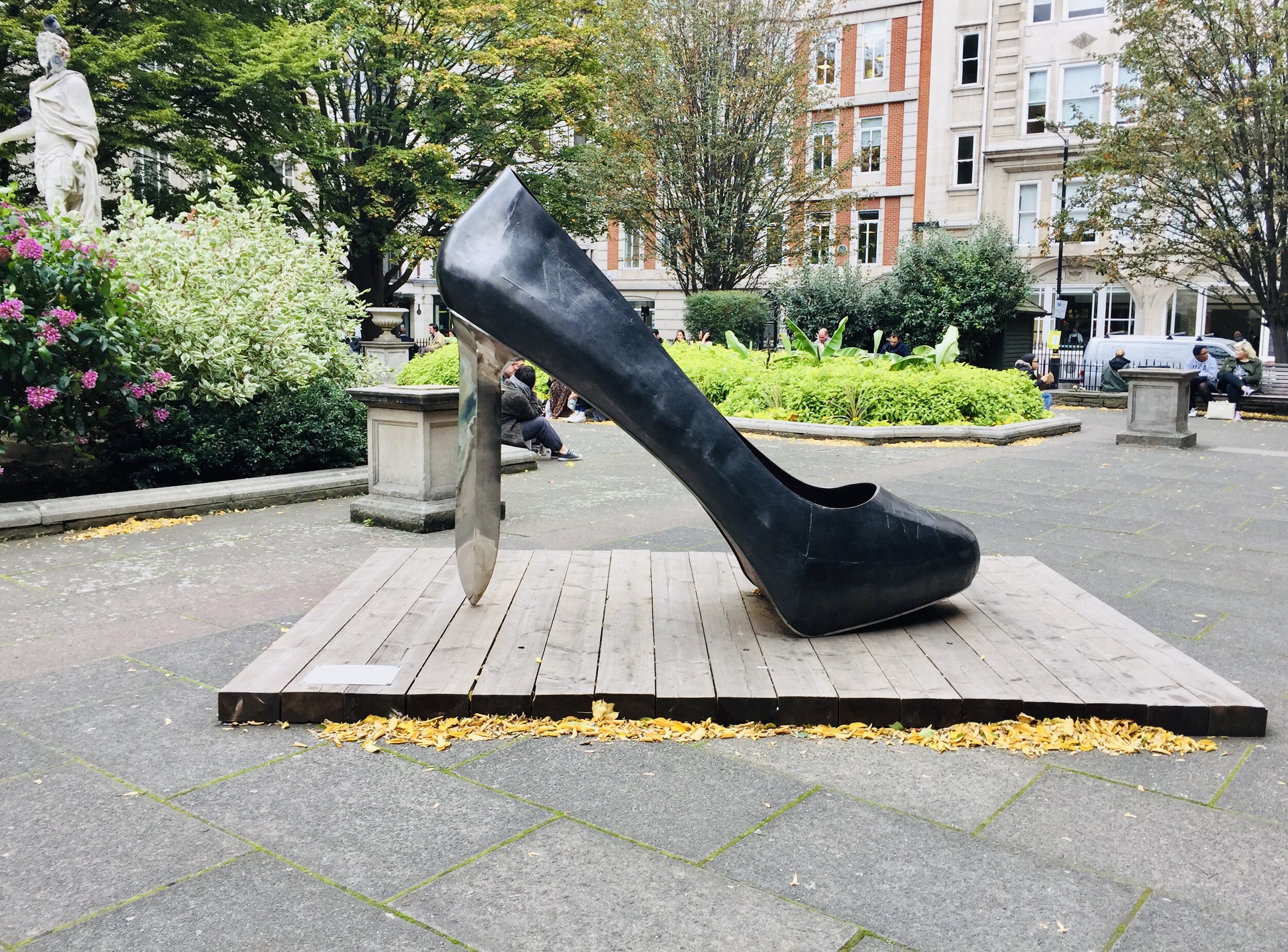The good fighter
There is a short but elegant story by J.G. Ballard about the dead body of a drowned giant washed ashore a beach, near a small city, and the reactions of the startled people around it as it’s decomposing into a peculiar monument of the impossible. This story came into my mind when I first saw Kalliopi Lemos’ Tools of Endearment.
Inverting Ballards’ story to open a contemporary discourse about new femininity, these ambiguous and enormous Lemos’ objects, a -literally- stiletto heel pump, a bra left on the floor and a corset-armour, all made of steel, could be seen as the remains of a giantess’ boudoir, leftovers of a goddess’ panoply after a fight, indicating the beginning of a post-feministic narrative about beauty, oppression and power. Gracious monuments of the possible, of a tangible present and a future under construction while the imaginary giantess-heroine is very much alive and strong.
Kalliopi Lemos has been approaching woman issues through the whole of her work with exceptional sensitivity and specificity. Cohesive substance in her multidimensional artistic practice is her broad humanitarian vision. An authentic care for every otherness and an eagerness to give back the powerless her/his lost dignity. Her Woman captured in animal bodies, imprisoned mermaid, lost and desperate immigrant or fetishized female body, balancing between glorifying beauty and archetypal pain, is the eternal symbol of any marginal, repressed or subjugated being.
The appealing phantom behind those neo-surrealistic pieces of hers (a combination of the fetishistic object of Meret Oppenheim, the suffocating image of Frida Kahlo’s torso and the cumbersome sculpture-costumes of Rebecca Horn that could transform her into superhuman) has multiple faces and temporalities:
A contemporary career woman or a suffragette fighting against inequality and subjugation, a cinematic Μetropolis’ robot from a past sci-fi vision or a non-gender cyborg, in the hyper-humanistic Donna Haraway’s approach, claiming not even humanization but just acceptance.
Besides, there is no substantial body. In Tools of Endearment Lemos’ Woman, not anymore enclosed in her embellishing costume, has arisen. The Big City became her boudoir and her after-battle field. The signified body has been liberated from its heavy uniform, from the roles that a male system of representation has imposed and made imperative. Its monumental, empty remains are shimmering, impressive and cold, while -in Bra and Corset- any ornamental details are made of rust. Oxidation functions here as a registration of time, a subtle reference to the history of women’s struggles within social and natural systems.
There is a witty antithesis’ game in Lemos’ sculptural idiom: between dimensions (a term of endearment is usually significant of something small and cute), material qualities (something that is supposed to be soft made by something hard) and space (the intimate place of a woman’s wardrobe challenging the urban landscape).
The sculptural synthesis thus seems to open a peephole/rabbit hole in the public space-time, while questioning the male gaze and the sexual objectification over the intimacy and autonomy of the female body through centuries.
This playful ambivalence is extending to the symbolic state. A beautifying object that restricts movement or even breath becomes a defence outfit that shields or even kills. The naked connoted body is therefore free or/and vulnerable. Balance could be the keyword here.
The search for balance is a continuous Lemos’ artistic quest after all, as well as the mythical suggestions of every narrative her art weaves. The Ulyssean nekyia behind her Navigation in the dark and the Ovidian theriomorphic, but gentle, figures constituting I am between worlds and between shadows are followed now by a contemporary version of the amazons, the female warriors’ tribe from Greek mythology, daughters of Aries, the god of war and the nymph Harmonia. There they are again the dipoles, harmony and war, beauty and fight, tenderness and suffocations, light and darkness.
In her seminal text about femininity and creativity, The laugh of the Medusa Helen Cixous describes the creation of a new “superb, equal and impossible” female subject, the “Universal woman” whose creative praxis could have the power to provoke actual transformation of social structures and change the dominant male “libidinal and cultural economy”. In her poetic manifesto, Cixous talks about the guiltified and thus “confiscated” woman’s body that is finally emancipated through the articulation of a female voice.
It is feminine creativity that “gives woman back her immense bodily territories which have been kept under seal” due to patriarchy.
These “immense bodily territories” are being actualised through Lemos’ sculptures. The giant woman aka Universal woman, stripped of her beautifying prison, her enormous corporality materialised imaginatively in the urban space within a monumental synthesis/ reminder of past restrains, a signifier of future assertions.
“As a militant, woman is an integral part of all liberations” affirms Cixous, but a “woman without a body can’t possibly be a good fighter”.
Through Tools of Endearment Lemos gives woman back her body, making her, like this, the “good fighter” she should and definitely can be.
London 2017
